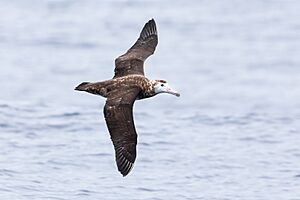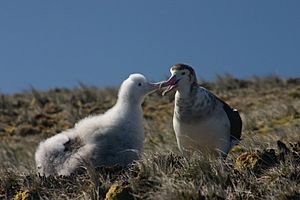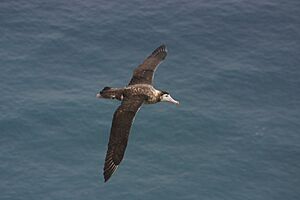Amsterdam albatross facts for kids
Quick facts for kids Amsterdam albatross |
|
|---|---|
 |
|
| Adult in flight | |
 |
|
| Amsterdam albatross feeding chick | |
| Conservation status | |
| Scientific classification | |
| Genus: |
Diomedea
|
| Species: |
amsterdamensis
|
| Synonyms | |
|
Diomedea exulans amsterdamensis |
|
The Amsterdam albatross (Diomedea amsterdamensis) is a very large seabird. It lives and breeds only on Amsterdam Island in the southern Indian Ocean. Scientists first officially described this albatross in 1983. For a while, some thought it was a type of snowy albatross.
However, recent studies of its mitochondrial DNA show that the Amsterdam albatross is its own unique species. This makes it different from other albatrosses like the snowy, Antipodean, and Tristan albatrosses.
Contents
About the Amsterdam Albatross Family
Albatrosses belong to a bird group called Procellariiformes. This group also includes birds like shearwaters and petrels. These birds share some special features. They have unique nose tubes called naricorns on their upper beak, though the albatross's nostrils are on the sides.
Their beaks are also special, made of several hard plates. Another cool thing is that they can make a special "stomach oil." This oil helps them defend themselves from predators. It's also a super energy-rich food for their chicks and for adult birds during long flights.
What's in a Name?
The scientific name Diomedea amsterdamensis has an interesting story. Diomedea comes from an old Greek hero named Diomedes. Legend says his friends were turned into birds. The second part, amsterdamensis, simply means "from Amsterdam," which is the island where these birds are found.
What Does the Amsterdam Albatross Look Like?
The Amsterdam albatross is a type of great albatross. Unlike many albatrosses, adults are mostly brown instead of white. This bird can weigh between 4.8 to 8 kilograms (10.6 to 17.6 pounds). It is about 107 to 122 centimeters (42 to 48 inches) long. Its wingspan is huge, reaching 280 to 340 centimeters (9.2 to 11.2 feet) across!
Adult birds have chocolate brown feathers on their upper body. Their face, throat, lower chest, and belly are white. They have a wide brown band across their chest and brown feathers under their tail. Their beak is pink with a dark tip and dark edges. When they fly, you can see their white underwings with a dark tip and a dark front edge.
Where Do Amsterdam Albatrosses Live?
The Amsterdam albatross breeds only on Amsterdam Island. This island is part of the French Southern Territories in the southern Indian Ocean. They build their nests high up, between 500 and 600 meters (1,640 and 1,970 feet) above sea level. This area is called the Plateau des Tourbières.
Scientists are not entirely sure where these birds go when they are not breeding. However, there have been possible sightings near Australia and New Zealand.
How Do Amsterdam Albatrosses Behave?
Because there are so few Amsterdam albatrosses, we don't know everything about what they eat or where they go at sea. However, it's believed they mostly eat squid, crustaceans (like crabs), and fish. When parents are taking turns incubating their egg, the "off-duty" bird can fly very far. They might travel up to 2,400 kilometers (1,500 miles) across the Indian Ocean.
Breeding and Raising Chicks
Amsterdam albatrosses usually breed every two years in open, marshy areas. Both parents take turns sitting on the egg to keep it warm. Each parent incubates for about a week at a time. After about 80 days, the chick hatches.
The chick stays under a parent for about a month to keep warm. It takes a long time for the chick to grow its feathers and be ready to fly, about 230 days! At first, the parents feed the chick every three days. As the chick gets bigger, they feed it less often. When the chick is heaviest, it actually weighs more than its parents. But then it loses weight as it uses those extra reserves to grow its flight feathers.
Once the young bird can fly, it stays at sea for about five years. After that, it returns to the breeding colony. It will start breeding itself a few years later.

Protecting the Amsterdam Albatross
The IUCN (International Union for Conservation of Nature) lists the Amsterdam albatross as endangered. This means it's at high risk of disappearing forever. Their total living area is huge (4,400,000 square kilometers or 1,700,000 square miles), but their breeding area is tiny, only 7 square kilometers (2.7 square miles). The Bonn Convention, an international agreement, also considers them endangered.
When they were first discovered, there were only five breeding pairs. Thanks to conservation efforts, this number has grown to between eighteen and twenty-five breeding pairs. Since 1983, scientists have watched them closely. Today, there are about 80 adult birds and around 130 birds in total.
Threats to Their Survival
The island where they breed has changed a lot. Animals brought to the island by humans, like ship rats, feral cats, and cattle, have harmed their habitat. At sea, the birds are threatened by a fishing method called longline fishing. Also, draining a peat bog on the plateau has damaged their breeding ground. Because they only breed in one place, they are also very vulnerable to diseases like avian cholera.
What's Being Done to Help?
To help save these birds, scientists put bands on their legs to track them. They also count the birds often. All the wild cattle were removed from Amsterdam Island in 2010, which helped improve the habitat.
Albatrosses live a long time, don't have many chicks, and start breeding later in life. This makes them very sensitive to things that harm their population. The number of albatrosses around the world started to drop when industrial long-line fishing became common. Studies show that fishing near breeding areas harms populations more than fishing far out at sea.
It seems that long-line fishing for southern bluefin tuna affected the Amsterdam albatross population from the mid-1960s to the mid-1980s. This was when fishing happened in their feeding areas. Experts believe that long-line fishing could remove about 2 to 16 albatrosses (about 5% of the total population) each year. In 2007, scientists estimated the population had grown to 167 birds. This increase happened as long-line fishing decreased in the southern oceans. To protect breeding birds, it's suggested that fishing should happen outside their feeding areas.


